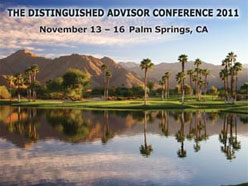
Investment portfolios have seen little growth the past few years and unhappy with this outcome investors are now looking at alternative portfolio strategies.
The European crisis is anything but resolved, the U.S. is on the verge of recession and the world is looking to emerging markets to provide growth, but, in the long run, that’s a challenge, too, says Richard Croft, author of Proven Strategies for Bold Investors and speaker at The Knowledge Bureau’s 2011 Distinguished Advisor Conference in Palm Springs, California.
“At what point does an economy that is growing exponentially begins to slow,” he said of emerging markets. “The economy gets to a point where it’s difficult to grow at the same pace; I’m not sure we are going to be able to stand back and rely on [BRIC countries] being able to pull us out.”
The fact that Eurozone is a big buyer from India, slow growth in Europe is going to slow down emerging countries prematurely, he said.
Given that there is so much negative sentiment in the market, Croft says it is imperative to apply some alternative strategies to generate cash flow.
One such strategy is what he calls the “barbell approach”. It is a strategy that allows one portion of the portfolio to achieve high yields while the other portion minimizes risk.
“Your portfolio needs to include preferred shares because of tax credits, it needs to seek out cash flow through high yielding common stocks and covered call writing, your clients should have some defensive positions like gold,” he said. “That will weather the storm.”
Personally, Croft is not a big fan of gold bullion. “I tend to have gold producers; gold producing stocks tend to be very good covered option writing plays.”
He also favours stability of income to variability of the portfolio.
“If you’re at a stage of your life where you’re relying on income then what you really need to look at is the cash flow that’s coming every month,” said Croft. “The problem with portfolio is that investors see both sides – the net equity and income – and it’s very difficult [for money managers] to get them to focus only on one side of it.”
The objective, ultimately, is to limit the erosion of principle so that a portfolio has a real chance of lasting until the client reaches 100. “To get clients comfortable with this objective, you need to get them focusing on the cash flow of the portfolio and not the value of the portfolio.”
Croft says that we are probably in for a prolonged period of volatility and that the 10% per year is all but gone. The portfolio, therefore, needs to be structured around objectives not crisis.
On the subject of crisis, he said the next one will devalue currencies of countries that have too much leverage, which will put upward pressure on the price of gold.
“If the U.S. gets the third instalment of quantitative easing, it will drive up the price of gold because that will devalue the dollar, that’s ultimately what added liquidity does to the system,” he said. “There is a lot of confusion, and I don’t know why, as to why gold hasn’t done very well lately. The fact that gold hasn’t done well lately is because the U.S. dollar has strengthened and [that happened] because Operation Twist [Federal Reserve Chairman Ben S. Bernanke’s bond-swap program] that the fed is currently involved in, doesn’t require any new capital.”